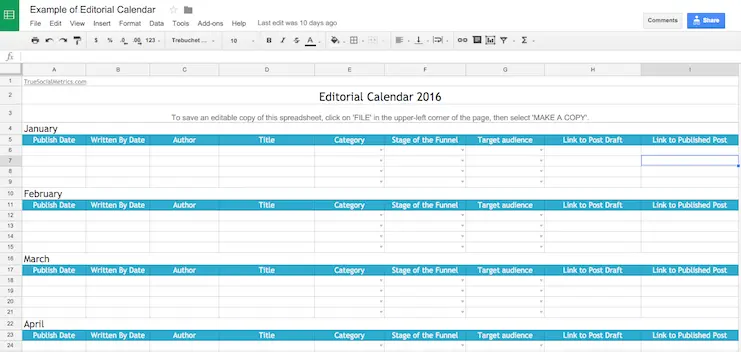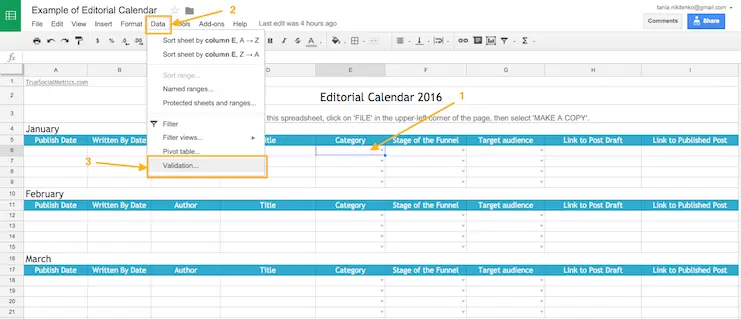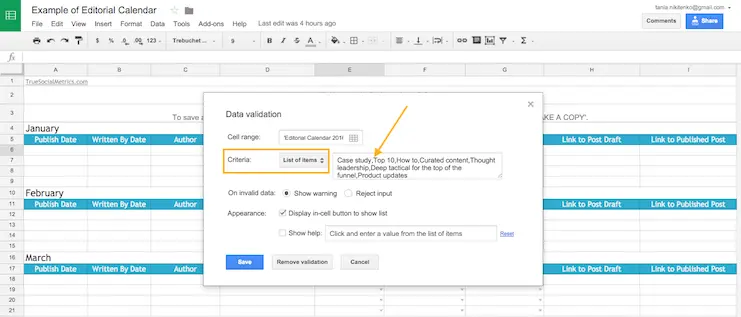Editorial Calendar Template to Save Time and Boost Your Social Presence
by Member of TrueSocialMetrics team ~ 4 min
Let’s face it. Content creation is messy. You’ll need to post regularly to see results; don’t just sit and wait for your muse. But that’s not how it usually happens. There’s a way to make it less chaotic, though: Using Editorial calendar (Content calendar). When you plan ahead you save tons of time and avoid stress. And hopefully, get more regular posting and more visits to your site.
Today I’m happy to share with you an Editorial calendar template for blog that we use here at TrueSocialMetrics. You can download your editable version of the Calendar here: https://docs.google.com/spreadsheets/d/1Qg9dDfCfUgMsH-OvtfGHkHcmtt7LMIE0z7DVAcgYB9Q/edit#gid=0. Just go to “File” and select “Make a copy”.

This calendar was inspired by the Laura Reuder’s Social Brilliant course.
Let me explain some of the columns here.
Stage of the Funnel and Target audience
When you plan your next blog post it’s better if you don’t just post something out of the blue but instead think about at whom this post might be targeted? Attracting new users? Retaining existing paid users? Or converting users in your free trial?
And as Rand Fishkin wisely points out in his Whiteboard Friday - don’t try to aim your blog post at more than 2 stages of the marketing funnel. Don’t chase all the goals at once, it will only get you in trouble.
"Stage of the funnel" and your "Target audience" correlate with each other. So for example, if you choose ‘Retention stage’ in the "Stage of the Funnel" column it is only logical to choose ‘Paid users’ in the "Target audience" column. While these two columns may seem overlapping, for me it’s more convenient to have both. By looking at the "Target audience" column you’ll instantly know where to promote your blog post - maybe send a newsletter to your ‘Paid users’ list of emails or an email blast to your ‘Trial users’ segment, or share it all around the web for ‘New users’. And by looking at the “Stage of the funnel” column you’ll know what metrics to measure the success of each exact post with. Using Conversion rate for ‘Conversion stage’, or Number of trial sign ups for ‘Comparison stage’; or Number of Visitors for ‘Awareness stage’.
Category
Think about the groups that your blog content might fall into to make your content creation proccess more structured and your brainstorming more targeted. For example:
- Case Studies
- Curated Content
- Thought leadership
- Deep tactical with your brand tie in
- Tactical for the top of the funnel
- Product updates and announcements
All these categories require different sources and types of information to create a post. For example, case studies will require a real example for your users and communication with your customers to create such a post. While curated content will require extensive web research to find relevant content.
In addition to that, each category has a different level of converting power and power to drive new leads. Using several post categories will help you create a nicely balanced, diversified content strategy. And your blog will fulfill all the goals for each stage of the marketing funnel and customer personas.
To edit drop down lists in your copy of the calendar, select the needed cell in the spreadsheet, then go to “Data” and select “Validate”:
Choose “Lists of items” option for ‘Criteria’ and specify your items separated by comma (without spaces between comma and words):
Now you are all set and ready to rock!
I’d love to hear what you think and if you have any questions about the template, drop me a line.
When you’re ready to rock your social media analytics
give TrueSocialMetrics a try!
Start Trial
No credit card required.




